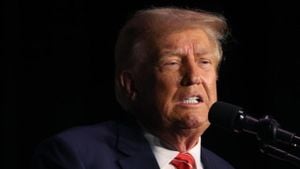The Indian stock market is facing significant challenges as the key benchmark indices, the BSE Sensex and the NSE Nifty, registered continued declines, extending the unsettling trend over consecutive sessions. Recent trading saw the 30-share Sensex drop by 156.72 points, closing at 77,423.59, and the Nifty slid 64.25 points to land at 23,468.45. This marked the latest chapter of uncertainty for investors as the market grappled with relentless selling pressure from foreign institutional investors (FIIs) and bearish trends from global counterparts.
For the past week, the domestic equity markets experienced more than a 2.5% decline, shattering previous stability as fears gripped sellers. The index saw its seventh consecutive session of losses, prompting concerns among market participants, especially with the upcoming holiday-shortened trading week looming on the horizon. The corporate earnings season has largely concluded, leaving investors wary as they await potential shifts from foreign funds, which are expected to play pivotal roles moving forward.
Interestingly, the rupee did show some signs of recovery, appreciating against the US dollar by 8 paise to reach 84.38. This occurred even as the dollar strengthened globally, largely attributed to lower international crude oil prices.
During Friday’s trading, equity benchmarks revealed how fickle market sentiment can be, as FPIs offloaded ₹1,849.87 crore worth of stock, continuing their trend of massive withdrawals. Since the beginning of November, investors have receded from the market with net outflows totaling ₹22,420 crore. Factors such as elevated domestic stock valuations, greater allocations toward Chinese equities, and rising U.S. Treasury yields exacerbated this trend.
Analysts like V. K. Vijayakumar, Chief Investment Strategist at Geojit Financial Services, highlighted the uncertainties, noting, "Although Nifty has corrected by 10.4% from its peak, there's no clear indication of sustained recovery just yet. The relentless selling from FIIs and earnings downgrades for many stocks are weighing heavily on market action." He adds concerns about how shifting global sentiments, especially relating to the U.S. elections, may affect market dynamics.
From the 30 stocks on the Sensex, notable laggards included IT heavyweights like Infosys, HCL Technologies, and Tata Consultancy Services. Other significant decliners included NTPC and IndusInd Bank. Conversely, stocks like HDFC Bank, Tata Steel, and Bajaj Finance managed to post gains amid the general downturn.
Looking outward, Asian markets exhibited mixed signals; some regions like Seoul and Shanghai showed improvements, whereas Japan's market reflected on its own worries. This disparity reflects the broader concerns among investors about global economic health. Major external headwinds—like rising crude oil prices, with Brent crude increasing by 0.51% to $71.40 per barrel—also play roles in the Indian markets' volatility.
The Indian markets, which had briefly rallied to their all-time highs earlier this year, are now wrestling with how to navigate this turbulent period. Global investment trends suggest older investors might pivot toward U.S. equities, pulling capital away from Indian markets. The abrupt retreat of foreign funds has rattled local traders, many of whom are re-evaluing their positions moving forward.
Investors are advised to stay cautious, with many analysts mulling over what the current selling spree might indicate about investor sentiment and future movements. The intricacies of the market are never simple, and these recent fluctuations serve as reminders of the volatility inherent to stock trading. Time will tell how these dynamics play out as investors and financial players react to changes both domestically and internationally.
With the markets on edge, one thing is clear—the Year 2024 will present unique challenges as the Indian economy continues to navigate through both local and global economic uncertainties. Investors and analysts alike will be attentively watching indicators and comments from influential figures to forecast future trends.



